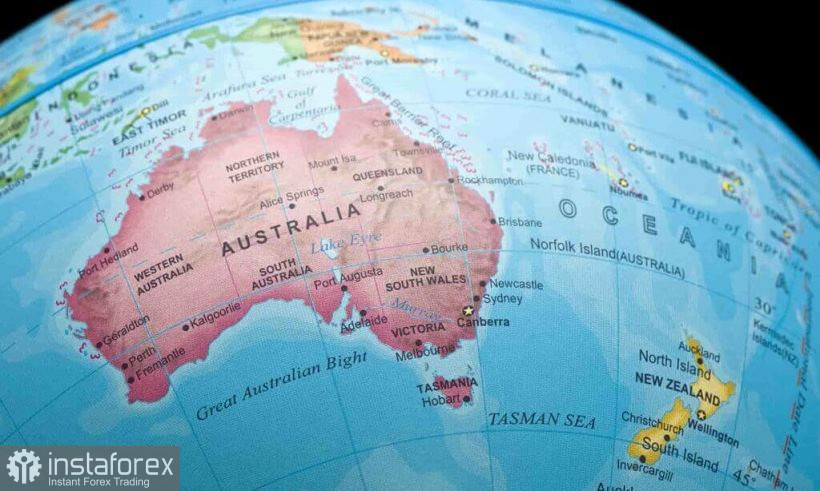The Australian dollar paired with the New Zealand currency feels very confident. The AUD/NZD cross pair has been actively growing for the third consecutive day, approaching three-year price highs. The latest data on the growth of Australian inflation only strengthened the upward trend, despite the fact that the release itself came out in the red zone. In general, the fundamental picture is in favor of further growth of the cross - at least to the level of 1.1190 (the upper line of the Bollinger Bands indicator on the daily chart).
But let's start with Australian statistics. In the second quarter, the overall consumer price index rose to 6.1% (year-on-year). On the one hand, experts expected to see a stronger result (6.2%). On the other hand, this is the strongest growth rate since 2001. Price increases were recorded in almost all categories. For example, real estate prices in the primary market increased by 9%, transport services (logistics) increased in price by 13%, essential goods - by almost 8%.

It is noteworthy that inflationary growth is caused not only by the energy crisis and/or geopolitics. The weather also contributed to the inflationary process. Or rather, bad weather. So, in the second quarter in Australia, fruit and vegetable prices rose significantly due to crop failure on the east coast against the backdrop of heavy rains.
However, in quarterly terms, the CPI unexpectedly slowed to 1.8% (against the forecast of a decline to 1.9%). Over the previous three quarters, this indicator showed consistent positive dynamics, reaching 2.1% in the first quarter. This circumstance made it possible to assume that inflation nevertheless reached its peak. However, this is a highly controversial opinion. Many experts point to the fact that employment in Australia continues to grow rapidly, and this fact indicates a revival of the economy, and, accordingly, the desire to spend the accumulated funds that were saved earlier (including during periods of coronavirus restrictions). Against this background, we should not expect a weakening of price pressure - it will certainly not only remain high, but also exceed the forecasts of most analysts.
Therefore, despite the "red color" of today's release, the market is almost certain that the Reserve Bank of Australia will raise the interest rate by 50 basis points on August 2, announcing further steps in this direction.
It should be noted here that inflation in New Zealand also demonstrates record growth. According to the latest data, the CPI hit a 32-year high in the second quarter. In particular, the cost of fuel jumped by 30% (y/y). Compared to the first quarter of 2022, consumer prices in the country rose by 1.7%, exceeding the median estimate of 1.5%. After this release, there were rumors on the market that the RBNZ would decide on a 75-point increase in the rate.
With such a disposition of a fundamental nature, the dominance of the Australian dollar paired with the New Zealand dollar looks, at first glance, anomalous. In my opinion, the upward trend of AUD/NZD is due to further prospects for tightening the monetary policy by the RBNZ and the RBA. Thus, according to currency strategists at Rabobank, the New Zealand central bank has tightened its monetary policy too actively compared to its counterparts, so it can reach the peak of interest rates earlier than other central banks.
Here it is necessary to recall that back at the April meeting, the RBNZ voiced the phrase that the members of the central bank agreed on the so-called "path of least resistance", the essence of which is to conduct several rounds of large-scale hikes ("raise more now, not later"), and then take a wait-and-see attitude. Based on the concept declared by the RBNZ back in the spring, the assumptions of Rabobank analysts look quite logical.
In turn, the RBA began to tighten monetary policy only in May, and at a rather cautious pace: at first, the RBA increased the rate by 25 points, then by 50, after that - by another 50 points. According to ANZ economists, key macroeconomic reports will force the RBA to raise the rate above the lower limit of the neutral range. According to their forecasts, at the end of the year the rate will be at the level of 3.35%. To do this, the central bank will need to increase the rate by 50 basis points at almost every meeting this year (except for one).
In my opinion, the immediate target for AUD/NZD bulls in the medium term is 1.1190, which is the upper line of the Bollinger Bands indicator on the weekly chart. In general, in favor of the further development of the upward trend, both the signals of the "foundation" and the "technique" speak. On all "higher" timeframes (from H4 and above), the pair is either on the top or between the middle and top lines of the Bollinger Bands indicator. In addition, the Ichimoku indicator has formed one of its strongest bullish Parade of Lines signals on the daily and weekly charts. Therefore, it is advisable to use any corrective rollbacks to open long positions. The main target is 1.1190.
 English
English 
 Русский
Русский Bahasa Indonesia
Bahasa Indonesia Bahasa Malay
Bahasa Malay ไทย
ไทย Español
Español Deutsch
Deutsch Български
Български Français
Français Tiếng Việt
Tiếng Việt 中文
中文 বাংলা
বাংলা हिन्दी
हिन्दी Čeština
Čeština Українська
Українська Română
Română

